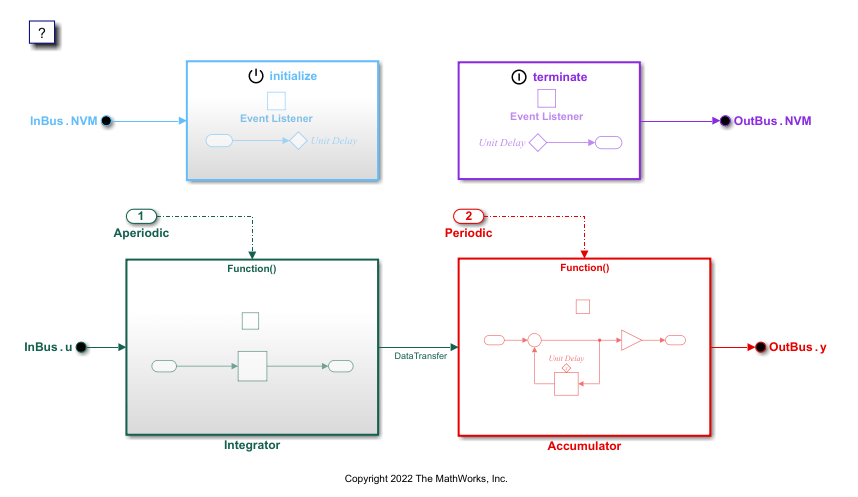Configure Data Transfer Service Interfaces for Data Transfer Signals
Within a target environment, execution entry-point functions communicate with other execution entry-point functions by calling the target platform data transfer services. In a component model, signal lines connecting communicating functions represent data transfers in the generated code. Communicating functions are modeled by using Function-Call Subsystem blocks that are aperiodic or periodic functions. Use the Code Mappings editor to configure the data transfer service interfaces when you do not want to use the default value specified in a shared coder dictionary.
By default, an Embedded Coder Dictionary provides an interface for these data communication methods:
Outside execution: The platform communicates data with other functions outside (before and after) function execution.
During execution: The platform service communicates data with other functions immediately during function execution.
For more information on data communication methods, see Data Communication Methods.
Configure Data Transfer Service Interfaces by Using the Code Mappings Editor
In this example, the component model references a shared coder dictionary that defines the default data transfer service interface for signals representing data transfers. To configure the data transfer to use something other than the default service interface, use the Code Mappings editor.
Open the component model,
ComponentDeploymentFcn.
openExample('ComponentDeploymentFcn');
In this model, the data transfer is represented by the signal connecting the two
Function-Call Subsystem blocks,
Accumulator and Integrator.
Verify that the component model references the shared coder dictionary,
ComponentDeploymentCoderDictionary.sldd.
In the Model Configuration Parameters dialog box, verify that the Shared
coder dictionary parameter is set to
ComponentDeploymentCoderDictionary.sldd. This dictionary defines
default service interfaces, including the default data transfer service interface, of
the component model.
Open the Embedded Coder app.
To configure a signal representing a data transfer to use a data transfer service interface other than the default defined by the shared coder dictionary, use the Code Mappings editor.
To open the Code Mappings editor, in the C Code tab, click Code Interface > Component Interface.
To populate the data transfer mappings, update the model diagram.
On the Data Transfers tab, notice that the Data
Transfer Service of the signal connecting the Function Call
Subsystems, DataTransfer, is set to Dictionary
default: DataTransferOutsideExe.

To configure the signal to communicate data with other functions immediately during
function execution instead of before or after execution as specified in the dictionary,
on the Data Transfers tab of the Code Mappings editor, set the
Data Transfer Service of DataTransfer to
DataTransferDuringExe.

Configure Data Transfer Service Interfaces Programmatically
To configure the data transfer service interfaces of a component programmatically, access the code mapping properties of signals representing data transfers in the component model.
Open the model.
openExample('ComponentDeploymentFcn');Get the code mappings for the model by using the
coder.mapping.api.get
function.
cm = coder.mapping.api.get('ComponentDeploymentFcn');In this model, the signal connecting the two Function-Call Subsystem blocks, Accumulator and
Integrator represents a data transfer. Get the current data transfer
service interface configuration by using the getDataTransfer
function.
ph = get_param('ComponentDeploymentFcn/Integrator', 'PortHandles'); dataTransServ = getDataTransfer(cm, ph.Outport, 'DataTransferService')
dataTransServ =
'Dictionary default'
To configure the signal to communicate data with other functions immediately during
function execution instead of before or after execution as specified in the dictionary, use
the setDataTransfer function and set the
DataTransferService property to
DataTransferDuringExe.
setInport(cm, ph.Outport, 'DataTransferService',... 'DataTransferDuringExe')
See Also
Code Mappings Editor | coder.mapping.api.CodeMapping